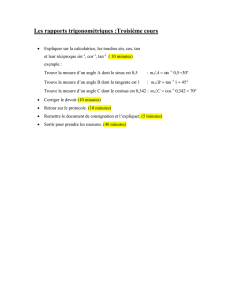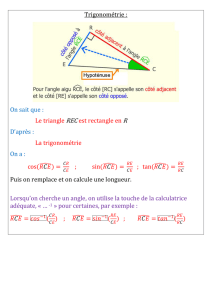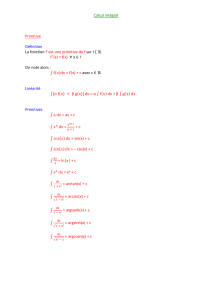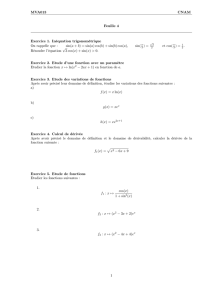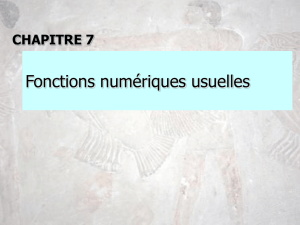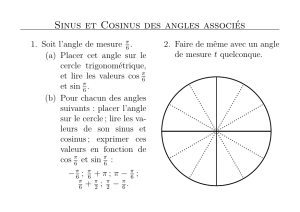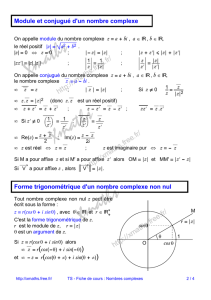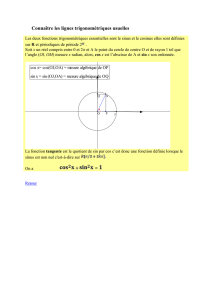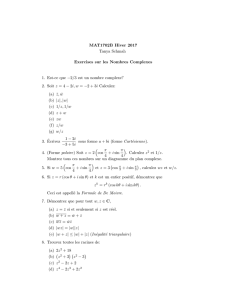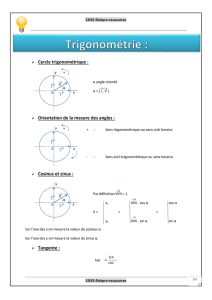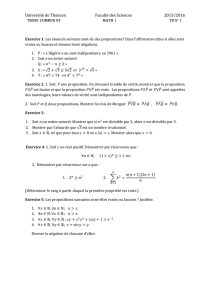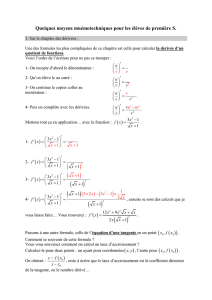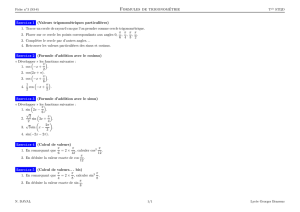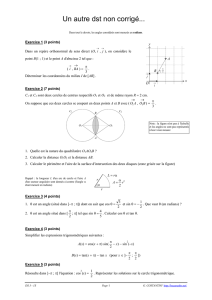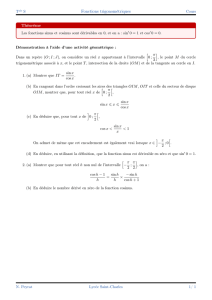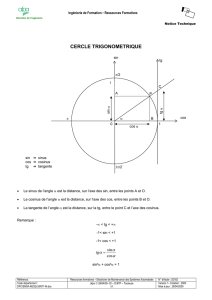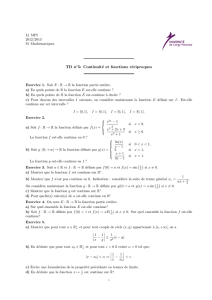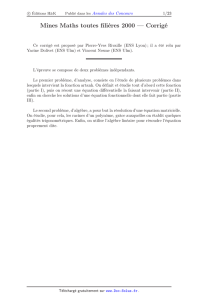diapos-chapitre7
publicité
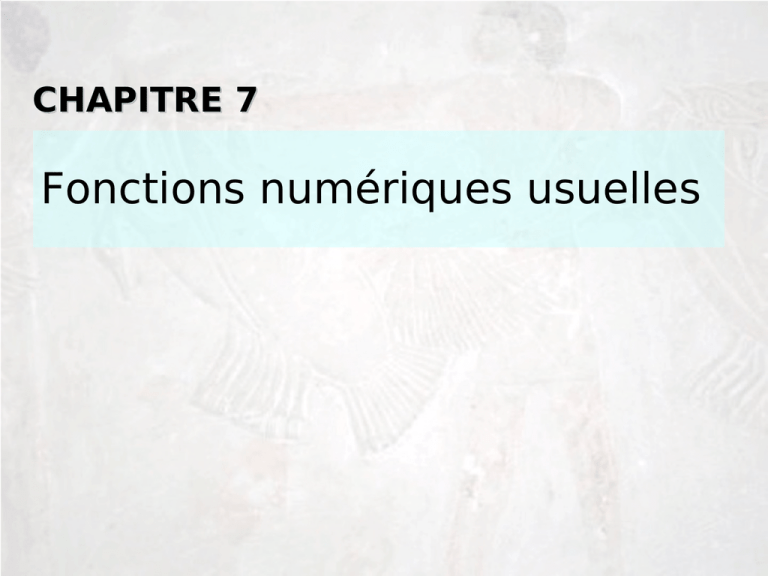
CHAPITRE 7
Fonctions numériques usuelles
Le plan du chapitre
•
•
•
•
•
•
•
•
•
•
La fonction exponentielle
La fonction logarithme
Les fonctions puissances
Les fonctions sin et cos ; relations entre les
lignes trigonométriques
Les fonctions Arcos et Arsin
La fonction tangente et la fonction Arctan
Quelques relations importantes
Les fonctions trigonométriques sinh et cosh
Les fonctions trigométriques inverses
Argsinh et Argcosh
La fonction tanh et son inverse
La fonction exponentielle
lim (ex/xn) = +∞
en +∞
k=n
∑
k=0
x
k
→
exp (x)
k!
lim (ex xn) = 0
en - ∞
exp (x1+x2) = exp (x1)
x
exp (x2)
La méthode d’Euler
exp ’ = exp
Étape 0 : Choix d’un « pas » : 1/N
u0 = 1
Dérivée « discrète »
un+1-un
= un
1/N
(1+ x/N)N ---> exp (x)
lorsque
N tend vers + ∞
La fonction logarithme (1)
x ∈
y
ℝ
> 0
et y = exp (x)
et x = log (y)
lim+∞ (log y /y) =0
lim0 (|y| log |y|) =0
log (y1 y2) = log (y1) + log (y2)
La fonction logarithme (2)
• log’ = [ y ---> 1/y] sur { y ; y > 0 }
• (log |y-a|)’ = [y ---> 1/(y-a)] sur ℝ \ {a}
Remarque : pour tout entier n de Z
différent de -1, on a sur ℝ \{a} :
[(y-a)n+1 / (n+1)]' = [ y ---> (y-a)n ]
a>0
Les fonctions puissance
x
∈
ℝ
ax := exp (x log a)
• (ax ) x = a x x
ax
• ax +x =ax
• (ab)x = ax bx
• a-x = (1/a)x
1
1
2
2
1 2
1
x
2
x
[ x ax]’ = [x log(a)
x
ax]
La fonction cosinus
x
k=n
∑
(-1)
k
k=0
cos 0 = 1
cos 2 <-1/3
∈
x
ℝ
2k
(2k) !
cos s’annule en au
moins
un point de [0,2]
→
cos (x)
(suites adjacentes)
π := 2 inf{x>0, cos x=0}
La fonction sinus
x
k=n
∑
k=0
(-1)
k
x
∈
ℝ
2k+1
→
sin (x)
(2k+1) !
(suites adjacentes)
Relations entre fonctions
trigonométriques
•
•
•
•
•
•
•
cos (x1 + x2) = cos (x1) cos (x2) – sin (x1) sin (x2)
sin (x1+ x2) = cos (x1) sin (x2) + sin (x1) cos (x2)
cos’ = - sin
sin’ = cos
cos2 x + sin2 x =1
cos (x+ 2π)=cos x
sin (x+2π) = sin x
(0,0)
1
(cos (x), sin (x))
( pour x ∈ [0, 2π[)
paramétrage bijectif du
cercle de centre (0,0) et de
rayon 1
Fonctions trigonométriques
inverses
• Arcos : [-1,1] --- > [0, π]
• Arcsin : [-1,1] --- > [-π/2 , π/2]
• sur ]-1,1[ Arcsin’ = 1/(cos(Arcsin)) = [y (1-y2)-1/2]
• sur ]-1,1[ Arcos’ = -1/(sin(Arcos)) = [y - (1-y2)-1/2]
Arcsin (y) + Arcos (y) = π/2 pour y ∈ [-1,1]
La fonction tangente
tan x := sin (x) / cos (x)
-π/2
π/2
tan’ = 1 + tan2
La fonction
Arctan (Arc-tangente)
x
∈
]-π/2 , π/2[ et y =tan (x)
y
∈
ℝ et x= Arctan (y)
1
1
Arctan’(y) = ------------------------ = ---------1 + tan2 (Arctan y)
1 + y2
Quelques relations importantes
• cos (t) = 2 cos2 (t/2) -1
= (1-u2)/(1+u2)
• sin (t) = 2 sin (t/2) cos (t/2)
= 2u/(1+u2)
t ∈ ]-π, π[
u= tan (t/2) , t = 2 Arctan u
1-u2
2u
--------- , ------1+u2
1+u2
(-1,0)
(0,0)
1
Un paramétrage rationnel
du cercle unité privé
d’un point
Les fonctions hyperboliques
• cosh x : = (ex+e-x)/2 , x ∈ ℝ
• sinh x : = (ex – e-x)/2 , x ∈ ℝ
cosh2 x – sinh2 x = 1
cosh’ = sinh
sinh’ = cosh
Intersection d’un plan et d’un cône :
hyperbole, ellipse ou parabole
hyperbole
(2
branches)
ellipse
les Coniques
Le paramétrage de la demi-hyperbole
x = cosh t , t ∈ ℝ
x2 – y2=1 , x>0
y = sinh t , t ∈ ℝ
La fonction argsinh : ℝ ℝ
x ∈ ℝ et y = sinh x
y ∈ ℝ et x=argsinh y
variable
auxiliaire
argsinh’ (y) = 1/cosh(argsinh(y)) = (1+y2)-1/2
sinh x = y
{
X = ex
X2 – 2y X - 1 =0
x = argsinh y = log [y + (1+y2)1/2]
La fonction argcosh :
{y ; y ≥1} → {x ; x ≥ 0}
x≥0 et y = cosh x
y≥1 et x=argcosh y
variable
auxiliaire
argcosh’ (y) = 1/sinh(argcosh(y)) = (y2 -1)-1/2 , y > 1
cosh x = y
{
X = ex
x >0 (donc X >1)
X2 – 2y X +1 =0
x = argcosh y = log [y + (y2 -1)1/2]
La fonction tangente
hyperbolique
•
tanh : x ∈ ℝ → tanh x := sinh x / cosh x
tanh’ : x ∈ ℝ → 1 – tanh2 x = (cosh x)-2
•
x ∈ ℝ et y = tanh x
y ∈ ]-1,1[ et x= argtanh y
argtanh’ y = 1/(1-y2)
= (1/2) x 1/(y+1) - (1/2) x 1/(y-1)
pour y ∈ ]-1,1[
argtanh y = log (|y+1|/|y-1|)1/2
, y ∈ ]-1,1[
Fin du chapitre 7
